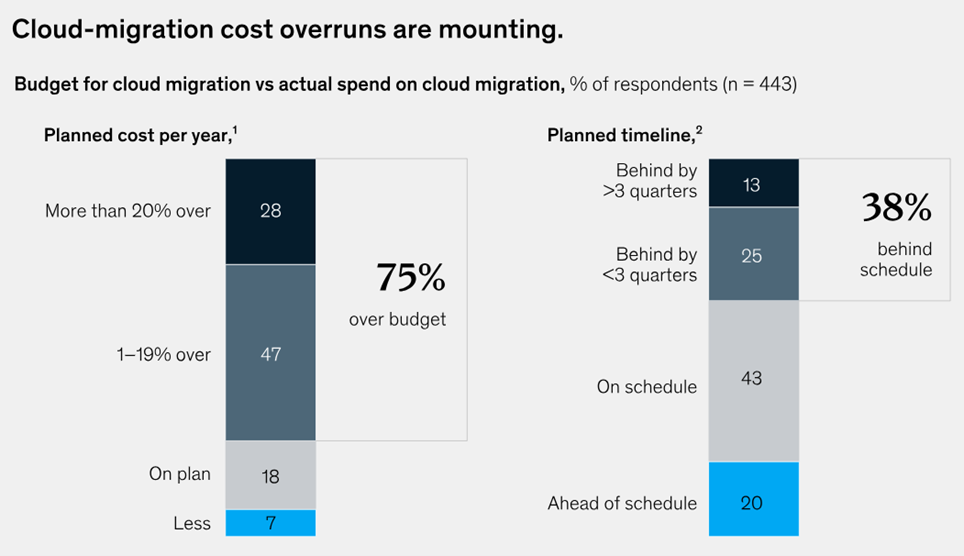Trapped in the cloud?
HOW ENTERPRISES CAN FIND THEIR WAY OUT
The rapid advancement in cloud technologies has seen many enterprises migrate their infrastructure and services to the cloud. While the cloud offers flexibility, scalability and (questionable) cost savings, it also brings forth challenges that might trap enterprises. This article breaks down the potential pitfalls of cloud dependence, the associated costs, and the benefits of migrating away from the cloud.
1. The Autonomy to Leave the Cloud
1.1. Vendor Lock-in Issues
A common challenge for enterprises in the cloud computing landscape is avoiding vendor lock-in. This situation arises when an organization becomes heavily reliant on a specific cloud provider’s tools and services, to the extent that moving to a different provider is both very difficult and expensive.
Underlying Risks:
- Dependency on proprietary tools and services that limit flexibility and innovation.
- High migration costs to move data and services to a new provider.
- Risk of data loss or operational disruptions during the migration process.
1.2. Data Sovereignty and Compliance
Storing data in the cloud means the data might reside in a different jurisdiction, subject to different laws.
Underlying Risks:
- Legal and regulatory requirements: Data stored across different jurisdictions must comply with varying legal and regulatory standards, which can be complex and challenging to navigate.
- Risk of data access interruption: Geopolitical events or sanctions can potentially impact data accessibility, leading to interruptions or loss of access to critical data stored in foreign locations.
2. Pricing and Cost Considerations in Cloud Services
2.1. Understanding Hidden Costs
While cloud services often promote scalability and pay-as-you-go pricing models, businesses need to be aware of potential hidden costs.
The case study of 37signals’ migration away from cloud services reveals significant cost considerations in cloud storage. In 2022, the company spent $3.2 million on cloud services, with nearly $1 million allocated for storing eight petabytes of files on AWS S3. To reduce these expenses, 37signals plans to transition away from cloud providers like AWS and Google Cloud, expecting to save $7 million over five years. This approach, while incurring substantial initial outlays for hardware
and data center costs, is projected to be significantly more cost-effective compared to the recurring expenses of cloud services. The company anticipates not only financial savings but also benefits like faster hardware and cheaper storage expansion as long as they can fit the new servers in their current data center setup.
Underlying Risks:
- Exceeding budget due to unpredictable costs.
- Incurring fees for data migration or API calls, which can accumulate.
2.2. Tracking Escalating Costs
As a business grows, the costs of using cloud services can escalate rapidly, especially if not managed effectively.
In McKinsey’s report on cloud migration, we can see that 75% businesses claim that they’ve exceeded their budgets and 30% see their cloud spend wasted (graphs below).
Underlying Risks:
- Surpassing budget allocations.
- Reducing profit margins due to increasing operational costs.
3. Impact on Workforce
The study from Les Echos on cloud migration outlines two main areas of concern:
- Human Resources and Skill Management: The move to cloud services affects the workforce, particularly those in traditional data center roles. These employees need new skills for cloud management, requiring training in both technical and soft skills to adapt to project-based work and the cloud environment. There’s also an opportunity to shift these roles towards cybersecurity and data protection.
- Governance and Strategic Planning: Effective cloud migration needs strong governance and collaboration across all levels of the organization. Leadership must strategically guide this transition to align with cloud culture. Without such strategic planning and governance, the shift to cloud infrastructure could face major obstacles.
Underlying Risks:
- Skill gap and workforce displacement.
- Operational disruption and resistance to change.
4. Selecting Appropriate Technology: Embracing Open Source Solutions
Open source technologies offer a viable alternative to proprietary cloud services. These solutions enable organizations to exercise greater control over their IT infrastructure, offering flexibility and customization options to meet specific needs.
Benefits:
- Reduced vendor lock-in.
- More control over data and infrastructure.
- Potential cost savings in the long run.
Underlying Risks:
- Initial setup and migration costs.
- Potential compatibility issues with existing tools and services.
Conclusion
The cloud offers numerous benefits, but enterprises must remain vigilant to the potential pitfalls. Vendor lock-in, hidden and escalating costs and data sovereignty are among the challenges faced. Open source solutions like Cloud Tiger offer a pathway to more autonomy and control. As businesses weigh the pros and cons, a clear understanding of risks and a strategy to mitigate them become imperative.
In the end, the choice to stay or leave the cloud should be based on individual business needs, long-term strategies, and a comprehensive understanding of the costs involved.
Additional resources: Cloud Tiger GitHub repository



Recent Comments